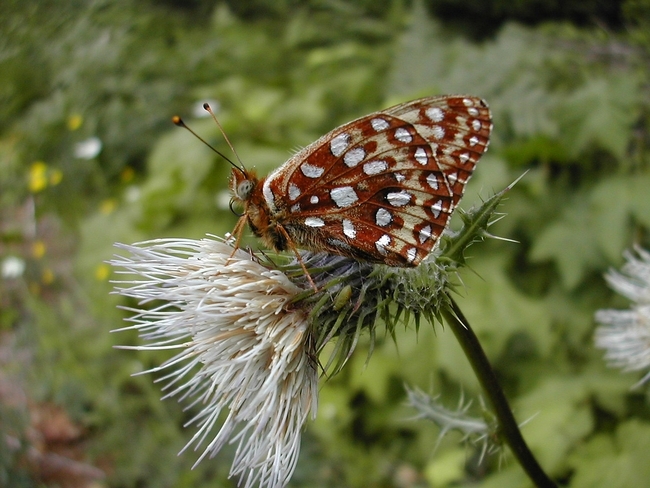
Henry will present an in-person and Zoom seminar, hosted by the UC Davis Department of Entomology and Nematology, on "Insect Conservation in an Uncertain Future" on Wednesday, March 2 in 122 Briggs Hall. Her seminar, open to all interested persons, begins at 4:10 p.m., Pacific Time. The host is Emily Meineke, assistant professor of urban and landscape entomology.
The Zoom link:
https://ucdavis.zoom.us/j/99515291076
"Key to protecting biodiversity in an uncertain future is understanding how populations will respond to future environmental change and incorporating this information into conservation strategies," Henry says in her abstract. "In this talk I will focus on 1) how changing precipitation regimes affect the phenology and population dynamics of subtropical species 2) the need to maintain historic disturbance regimes to increase population resilience to catastrophic hurricanes and 3) the importance of careful assessment of whether conservation strategies are working as intended. My studies of endangered butterflies and their host plants highlight mechanisms that link species life history to climate change responses and provide a framework for developing conservation strategies that are rooted in basic ecology."
Her research topics include the Oregon silverspot butterfly (Speyeria zerene hippolyta), a threatened butterfly on the Oregon coast. She was featured in an Oregonlive.com news article, July 17, 2021.
"The silverspot once ranged from the Long Beach peninsula in southwest Washington to northern California," wrote Quenton Smith of Oregonlive.com. "But when it was first listed as endangered in 1980, its only known location were on two 'salt-spray' meadows overlooking the ocean near Rock Creek south of Yachats."
"Wild populations were subsequently discovered nearby at Brays Point, and on Mount Hebo, Cascade Head and the Clatsop Plains south of the Columbia River. Over the years the butterfly disappeared from the Clatsop Plains and Long Beach peninsula."
The Oregon silverspot once inhabited "suitable coastal habitat from northern California, through Oregon, into southern Washington," according to Wikipedia. 'It can now only be found in the wild at a few remaining sites in California and Oregon.] Conservation sites include Cascade Head and the Rock Creek Wilderness in Oregon. The butterfly can also be found at Mount Hebo and Clatsop Plains in Oregon and at Lake Earl in California."
Butterfly guru Art Shapiro, UC Davis distinguished professor of evolution and ecology and author of The Field Guide to Butterflies of the San Francisco Bay and Sacramento Valley Regions, says "this subspecies is nowhere near here, but other zerenes are (but not in the Sacramento Valley)." His former PhD student, Rich Van Buskirk, now a professor at Pacific University, Forest Grove, Ore., studied the butterfly while at UC Davis and continues to do so. Van Buskirk and his colleagues recently received a $1.2 million, three-year federal grant to continue restoration work and research to protect the Oregon silverspot.
Henry focuses her research on how rare species populations respond to environmental change – whether management or environmentally driven – and how to convert this knowledge into successful management strategies. To answer these questions, I use detailed natural history observations, local and landscape-scale experiments, and quantitative population models. In all of my work, I collaborate closely with land managers to answer questions that directly fill knowledge gaps that impede on the ground decision making. These collaborations allow me to directly translate my research results into improved conservation plans that increase the probability of successful endangered species recovery."
Henry obtained her doctorate in biology, ecology and evolution, from North Carolina State University, specializing in conservation and population biology. She wrote her dissertation on "Disturbance and Conservation of At-Risk Butterflies." She holds a master's degree in environmental science from WSU, where she specialized in conservation and restoration ecology. Her thesis: "A First Step Toward Successful Habitat Restoration and Reintroduction: Understanding Oviposiition Site Selection of an Imperiled Butterfly, Mardon Skipper." She is an alumnus of Willamette University, Salem, where she studied biology and Spanish.
"As my dissertation concluded, I secured funding from both the National Science Foundation and Everglades National Park to continue my research evaluating the interacting effects of multiple disturbances on population dynamics," Henry writes on her website. "In early 2021, as my previous funding was wrapping up, I was recruited back to Washington State University to lead a research effort that aims to evaluate the effectiveness of different management strategies for Oregon silverspot butterflies."
Nematologist Shahid Siddique, assistant professor, UC Davis Department of Entomology and Nematology, coordinates the weekly seminars. For any technical issues regarding the Zoom seminar, contact Siddique at siddique@ucdavis.edu.
Attached Images:
